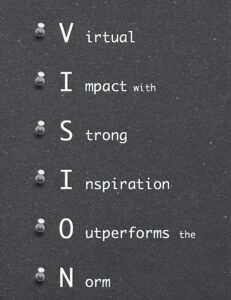Leadership is mostly about communication.
So, effective communication is also a key competency for virtual leaders.
This is now post #3 of an 8-post-series on the subject after the introduction and the one on self-leadership. And today, I would like to present you the second competency and reflect on how you can develop this further in order to strengthen your effectiveness as a virtual leader.
Let me first describe what I mean with this competency.
As this blog-series is specifically about a virtual context, I presume the basics of effective face-to-face communication are known and mastered well enough. The specific skills needed to be an effective communicator in a virtual organisation are first and foremost your awareness and ability to listen very carefully in virtual interactions. This is about picking up changes in voices in terms of pitch, speed and emotional loading. It also encompasses the ability to recognise what is being transmitted within the unspoken (or in-between the lines of written) exchanges. Beyond listening, it requires skilful expression of your messages to minimise ambiguity and foster engagement in the exchanges.

Being effective in communication is a competency for any context and any interaction. Hence, all fundamental skills like active listening and clearly structured expression of opinions or inquiry of other perspectives in combination with an open mindset are necessary for effective communicators. That applies to organisations as well as social interactions. Face-to-face settings give us the opportunity to use a combination of what’s being said, how it’s being said and the body language that comes along with it to communicate with other people effectively. In contrast to this, in virtual interactions and depending on the technology/platform being used, we are deprived of parts or all elements of the body language (should we work with or without video support). This can be very challenging if you have a preference for visual cues when you are involved in an ‘audio-only’ conversation.
In a virtual setting active listening and clearly structured expression or inquiry works best in combination with your ability to be very responsive yet concise in these interactions in order to keep the attention of the other persons involved high. Equally important is that you are technology savvy so that you can use the most appropriate platform/technology for the virtual interaction and the subject discussed.
In the following I will share my experience and some ideas about how you can develop this competency further to be as effective as possible in your virtual context:
Being aware
In order to enhance your awareness and skill of listening in virtual interactions focus first on developing your sensitivity to any cues associated with people’s way of speaking.
For example: can you hear their breathing and feel their emotional state when they explain something or present a point of view?
As this might be easier for you in a one-to-one interaction start there. Then expand your receptiveness for such cues to meetings with several people present.
Ask yourself the following questions:
- How often do I interrupt people even though they had not finished?
- How much do I pay attention to the emotions coming with contributions of people in various settings?
If this is already second nature to you, congratulations! If not, I recommend that you practice to listen and reflect on these questions after each of your virtual interactions to sharpen your sensitivity in this area. If you, like me, have a strong preference for visual cues it may take a bit of time to develop sensitivities to audio cues. But based on my own experience I can assure you it’s definitely worthwhile the effort.
Being concise
The second element of this competency is about being responsive and concise. I’m sure that you have the same or similar experience as I have with virtual teams where people seem to be distracted by other things which only become apparent when they are asked and the person responds by saying: can you say that again I didn’t “hear” it. In my experience this is very annoying to all others present because it usually means they had not paid attention. And such patterns bear the risk of destroying engagement and motivation in virtual meetings.
Hence, leading by example, you should never be distracted in a virtual meeting by anything happening around you. You need to be fully present and able to respond to the actual discussion at all times. In addition, you should take sufficient time to think through your responses rather than voice your thoughts if they are still unstructured.
The key here is to keep in mind that online time takes more energy and is very precious, hence, don’t squander it!
To be at your best and develop further ask yourself the following:
- What settings/surroundings do I need in order to minimise my distraction from virtual meetings?
- In which way can I assure, depending on the people participating in the virtual meeting, that I get enough thinking space to formulate concise responses in discussions?
- How can I make sure that everyone participating in the meeting is focused on the interaction and not distracted?
In one of my previous blogs I’ve described how you as the leader of a meeting can increase the engagement and motivation to participate. Check it out here for more details and potential ideas.
Being savvy
The third element is your familiarity with and skill to handle the technology platform you are using for your interactions. On one hand this requires you to feel at ease with the platform used on the other hand it needs a good understanding of functionalities and how to solve challenges some participants may face whilst interacting with you.
Even though this may sound banal as a lot of platforms seem to be very intuitive, you should get yourself trained in all the technologies you intend to use and stay up-to-date with their functionalities to master them when it counts.
I have come across many leaders who think that it is best to always use audio in combination with video and screen sharing in order to have the most productive interaction/communication. Unfortunately this is not true and it is another case of ‘horses for courses’. I recommend that you read one of my earlier blogs about technology selection to really focus on what is needed for the task at hand.
And if you are interested in an in-depth conversation about this or similar challenges please get in touch with me direct or share your thoughts in the comment section below.
Join us online! 
We explore this and other business relevant subjects in our Virtual Leaders Lounge. This is an informal online meeting of maximum 10 business leaders where we discuss challenges in virtual teams and organisations and share best practices. No PowerPoint is used, no prep work required!
Check it out here or register direct so you get the invitations and have a chance to get one of the 10 seats available for a lounge session.



